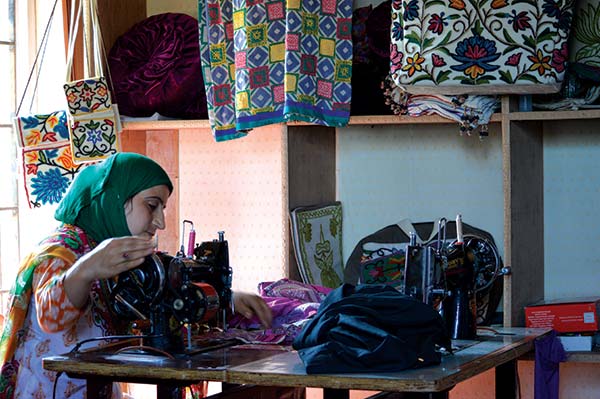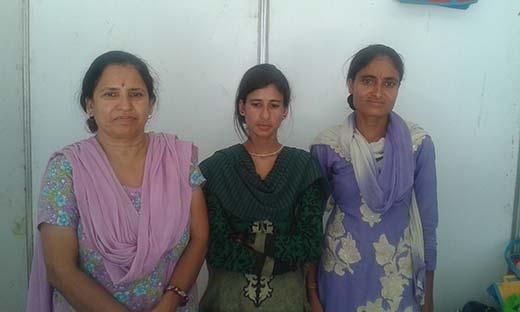It took little courage and a government initiative to change their lives around. Shakir Mir meets beneficiaries of Women’s Development Corporation to see how they learned skills and used them to change their fortunes

Tring Angmoo, a plump woman in her early forties is sitting with a pensive look. On a hot afternoon, she waves a plastic sheet across her face to fend-off the searing heat radiated by the corrugated tin-sheets forming the walls of her makeshift stall.
At her kiosk, she has spread out an array of items including embroidered clothes, cosmetic products, artificial jewelry and small packets of cumin seeds she has brought from her village in Kishtwar.
Her stall at Srinagar’s Polo Ground is among dozens of many others’ where women; destitute, widows and orphans, from across the state have participated in the State Exhibition organized by the Jammu and Kashmir Women’s Development Corporation (JKWDC).
Hailing from scenic Gulab Garh village located in Atholi (Paddar) Tehsil of Kishtwar district, Angmoo’s story captures an indomitable spirit of a woman who worked against odds to earn a better living for herself.
Born in a poor family, her father couldn’t afford to send her to school. She was married to a farmer at the age of 17. “I and my husband worked tirelessly on the land in our village yet the income we earned was paltry,” says 42-year-old Angmoo, wiping the sweat from her forehead.
Angmoo has two sons aged 15 and 18. “I am not educated but I always wished my children must never remain illiterate,” she says.
Angmoo says they used to put together money for daily bread but exorbitant fee of tuitions loomed over the careers of their sons.
One fine afternoon Angmoo heard some commotion outside the house. She went out and saw a lean man speaking to a knot of women and motioning towards them with his hands, as if trying to explain something.
The man left a short while later. The crowd was humming with discussions. The man in question was employee of JKWDC, and had been there to aware the local female-folk about possible micro-crediting schemes they could avail to.
Angmoo grabbed the opportunity and took out a loan of Rs 1 lakh.
“I spent Rs 40,000 to raise a small shop and travelled to Delhi to buy goods like jewelry and cosmetic products worth Rs 60, 000,” she sighs.
Within months, narrates Angmoo, their financial condition alleviated. “I was now earning around Rs 6000 per month besides repaying the loan in installments,” she says, smile curling one corner of her mouth.
She enrolled her sons in a private institution and ensured their fee is paid on time. Her husband toiled in fields, besides selling spices as a hawker to raise money for bread.
In Srinagar, Angmoo was participating in the State Exhibition to promote her articles. “I have been taking part in these exhibitions of late. I am scheduled to visit Jammu in December and then Jaipur next year.”
It is precisely these kinds of exhibitions that help Angmoo register a steep increase in her sales. “Tourists arrive in droves when they see an exhibition like this,” she says bursting into a fit of laughter. “That’s when I know the sale of the articles is going to pick up.”
The story of Angmoo echoes with those of almost 15,000 other women across the state who sought to make most from the micro-financing program of JKWDC, and labored their way towards self-empowerment.
At the center of the mission is 42-year-old Managing Director of JKWDC, Dr Naheed Soz who feels that teaching skills helps them become economically empowered and independent.
“Initially we teach them the saving habits, partnership values, homogeneity of the group,” says Soz, clearing her throat. “These groups become their home away from the home. They confide to each other, share their experiences. If anybody is in distress, the group solves the problem.”
These girls undergo a vocational training course (roughly 700 girls every year) and then 15-membered self-help groups are framed during the very course of their training. “Then we teach them inter-loaning, group mobilization, solutions for local village. If some lady is hospitalized or if someone’s child doesn’t have a school uniform, these groups make sure they mete out the help through the method of inter-loaning,” informs Soz.
After that, vocational training takes place where these women learn how to make fancy jute bags, fabric arts, artificial flowers etc. During that activity, not only do they work but simultaneously get to know about the things like group-formation, regulations, book-keeping and passbooks.
After the completion of training, final products are marketed in exhibitions. “Whatever the money is generated, is distributed among the group,” Soz adds. “This results in the confidence building among these women.”

Thirty-year old Shaheena Ali is a young woman who worked at a boutique in Hyderpora, Srinagar earning a modest income. She might not have been unhappy with her profession but she was not content either.
At her stall, she had colorful piles of embroidered fabric and jute bags laid separately meant to catch the attention of visitors.
“I learnt the art of embroidery at young age,” she says “Then I decided to go with this profession.”
Things changed for Shaheena slowly. “My husband works as a researcher at Kashmir University. The income we had was too little to satisfy our needs,” she says while letting out a sigh. “He had to set aside money for his research too.”
Shaheena too, was approached by workers of JKWDC. “They appraised me about the various loan schemes,” she says. “So I took out one.”
She invested the loan money in opening a boutique and purchasing raw materials to produce items like crewel curtails, jute bags, and pillows.
Besides, being credited with capital, Shaheena opted for a training course with JKWDC and was able to make many more items besides regular articles she made.
At these exhibitions, women like Shaheena get to market their products at a wider scale.
“People from different Indian states,” she says. “Like our products and purchase them in huge quantities.”
The luck doesn’t ends here. “We often get orders from many government organizations, and senior administrative officials,” says Shaheena, beaming.
Result? Shaheena adds more than Rs 7,000 to her monthly income and sometimes even twice. “My husband is no more worried about the money it will take him to undertake research,” she says adding that she alone is now capable to spend money for domestic purposes.
Working along with Shaheena is her colleague Yasmeen (28) whose family was involved in the business of making bedding mattress and quilts. Due to the nature of this work, Yasmeen couldn’t join them. “So I knew from the very beginning that I will have to search for something else to scrape a living,” she says, with a brooding look.
While Yasmeen was caught in her ambivalence, it was Shaheena who came to her rescue.
“She is my cousin,” Shaheena says, fixing her gaze at Yasmeen. “I told her about this loan scheme and then she agreed to take out one.”
Both of these women solicited a loan to the tune of Rs 2.5 lakhs and set out to start business together.
“I too got training at the UNDP,” Yasmeen says. “Before training, I was just able to do embroidery but now I am able to produce a variety of items.”
Agreement with United Nations Development Program (UNDP) is an initiative by JKWDC to sponsor the training programs across the state. A proposal was submitted by JKWDC to UNDP for four clusters; Jammu, Thana Mandi (Rajouri), Srinagar and Kulgam. Under the initiative, a highly reputed team of designers from the National Institute of Fashion Technology, Delhi imparted training in those clusters.
“After training was imparted, we developed prototypes,” Soz says. “Now we are doing pretty well in those clusters. For example in Rajouri-Poonch cluster we focused on flower making. Artificial flowers were manufactured of international repute. Then those beneficiaries participated in international fairs and they earned good amount of money.”
Yasmeen and Shaheena now own a boutique and work together. “We are happy now,” says Yasmeen. “We earn more than we had expected,” she says with an air of gratitude.
Just few meters away, Rajini Devi (21) is washing rice in a steel container. She is preparing to set alight her stove to cook food at her stall in the exhibition. Objects like artificial jewelry, jute bags, hand clutches are littered around in a mess. Rajini is a slender woman with an unkempt hair. Even the clothes she is putting on are worn off.
She hails from the Toph Manhasa village of the Jammu district. She has two brothers and two sisters who do not work. Rajini was among many unemployed women of her village for whom the prospect of self-sufficiency was elusive.
Considering the ailing condition of her parents, it had become difficult for her to earn money for feeding her 6 member family. “As I turned 16, I realized I had a massive task ahead,” Rajini says in a tone barely above whisper.
That’s when Rajini got introduced to JKWDC’s micro-financing schemes. When Rajini was speaking with this reporter, a burly woman from the next stall rose from her seat and walked up to us, “I saw these little girls once,” she chipped in.
Fifty-year-old Champa Devi from Samba had herself been a beneficiary of the JKWDC’s micro-financing program. “I had already been into this profession. So I decided to help some 15 odd girls from across the region. Rajini is one of them,” says Champa in voice that implies an air of authority.
Champa’s group was sanctioned Rs 2 lakh as lone. “The interest rates were considerably low and so were the installments, my girls got ready immediately.”
The girls were imparted with vocational training to enhance their skills at sewing, embroidery and a gamut of other things. Like most of other women, Rajini too invested the money in procuring the raw materials and then by the dint of her skill, turned them into lucrative products.
“Whatever money I earn, I send it to my parents besides earmarking some amount for personal needs,” Rajini says, smiling.
These exhibitions may look customary at face value but sometimes carry an element of serendipity. For instance, Rajini’s group got an order of Rs 10,000 from Mata Vaishno Devi Shrine board last year followed by an order of Rs 12,000 by Institute of Management and Public Administration (IMPA) to manufacture jute bags. “We also inscribe the items with the institutional logos,” she says while holding a folder they had hand-crafted for IMPA.
Soz’s organisation has been able to disburse a total of Rs 59 lakhs among the 1622 beneficiaries over the last three years. It was awarded 3rd rank by the Ministry of Minority Affairs as the best performing State Channelizing Agency (SCA) last year. But not unlike other sectors, it too grapples with a problem. “My organization is understaffed,” she says. There is problem of human resource shortage in her department so much so that her field supervisors double up as District Managers. “Out of the 22 total districts, I have just 5 District Managers. Can you imagine?” she says, arching an eyebrow.
Meanwhile, Rajini speaks with her co-partners and laughs heartily. Few years ago these women could not have known they could labour their way to success. The sense of self-worth is salient in these women.















